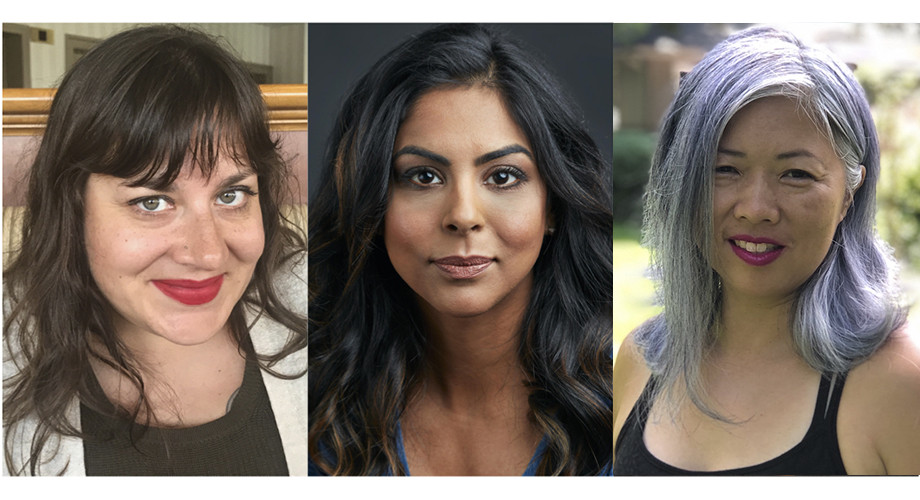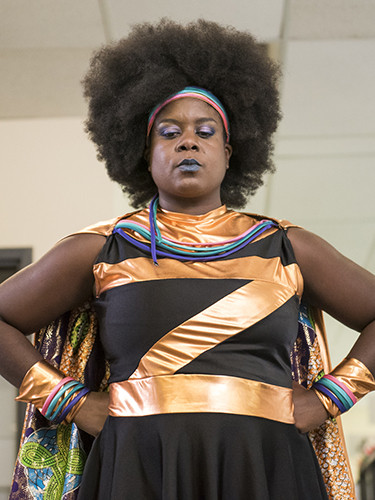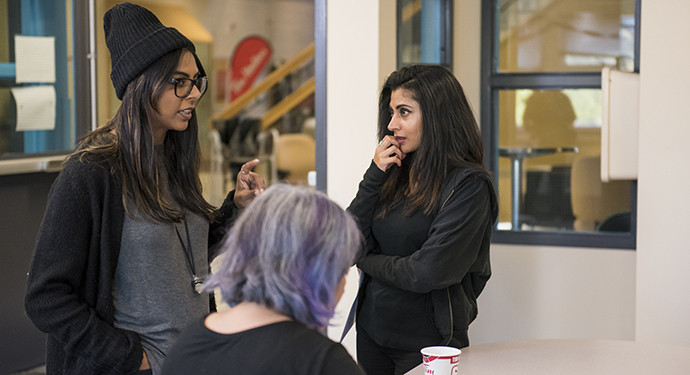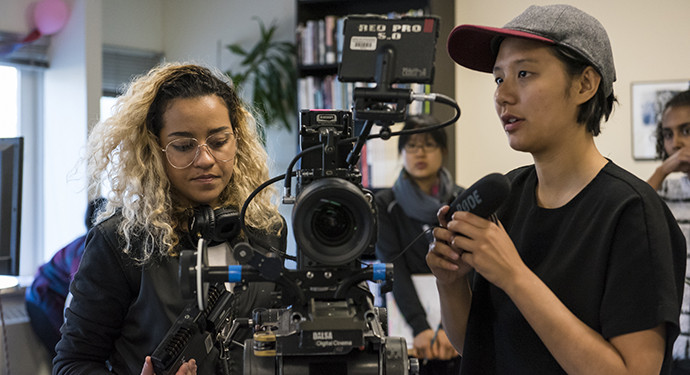Blog Series
Meet the Super Women Behind Super Zee!

The Women Behind Super Zee, left to right: Gillian Müller, Farah Merani, Nathalie Younglai. Image credit: Leilah Dhoré
Super Zee is an action comedy about a queer Black superhero saving the world from microaggressions. The crew behind it is made up entirely of People of Colour.
I had the privilege of talking about the show, the biz, and challenging what’s possible, with three of Super Zee’s four creators. (The fourth, writer-producer Jay Vaidya, was out working on the next ground-breaking project at the time of our interview.)
Nathalie Younglai is a Writer-Director whose credits span factual (Til Debt Do Us Part), children’s (The Magic Schoolbus: Rides Again) and primetime TV (Bellevue). She is the founder of BIPOC TV & FILM (Black, Indigenous and People of Colour in TV and Film) and serves on the Writers’ Guild of Canada Diversity Committee.
Farah Merani is an actress, writer and producer whose credits include Shadowhunters, Private Eyes, Nikita and Covert Affairs. She is one of the co-founders of Women On Screen and co-chaired the Diversity Committee at ACTRA Toronto from 2014-2108.
Gillian Müller is a Screenwriter, Producer, and former resident of the Canadian Film Center’s Primetime TV program. Her credits include Travelers, X Company, and Night Owl which was selected for SXSW in 2018. You need to read her blog.

Sedina Fiati as Super Zee. Image credit: Leilah Dhoré
SHAMELESS: Why did you decide to make Super Zee?
Farah Merani: I told Nathalie to! [everyone laughs] It’s actually not far from the truth! Go ahead, Nathalie.
Nathalie Younglai: I’d been working on the script for a while, and I had Sedina [Fiati] in mind to play the title character for a short film. As an independent filmmaker, it’s a massive undertaking to even think about doing a short. And I had lunch with Farah one day—
FM:—Because they were honouring her! She was getting the Sandi Ross Award for achievement in diversity in the film industry and being a leader!
NY: [laughing] I did cry in public. So, we were talking about our goals for the upcoming year, and dreams, and I told Farah about how I wanted to get back into directing, and she was just like, “let’s do it!” And then it happened. Like a month later! Because once Farah puts something out into the universe, the universe loves her, and it just responds to everything. [laughing]
FM: In all honesty, when I heard Nathalie talk about the concept, about this queer Black nerd superhero fighting injustices in the workspace, I was like: “This is genius!” I think it’s hilarious.
NY: I think even within that conversation, we already set out a parameter that we wanted to kind of make a statement, by crewing up with all People of Colour.
SHAMELESS: Let’s talk about that. Because I think there is a growing awareness, especially in recent years, that it’s important to see racial diversity on screen—but not so much when it comes to diversity behind the camera, which is actually lagging behind even further. Why were both of those things equally important?
NY: There’s a lot of initiatives right now in terms of seeing all-female crews, which is great. But a lot of times what I see when I Iook at those photos, is it’s still majority white women. And for me, that disconnect is really jarring. Because as Women of Colour, our issues, our identity, often gets erased, without even knowing it. Or, it doesn’t get acknowledged, when people in general are just talking about women, or feminism, and making sure that there’s gender parity. People that are very comfortable wrapping their minds around gender parity and saying 50/50, we need this—yet when it comes to “are we still getting representation of women of colour within those gender parity numbers?” it’s usually a “no.”

Producer Jay Vaidya (right) with Farah and Nathalie. Image credit: Leilah Dhoré
FM: The notion of intersectionality is super important. A white woman does not necessarily sympathize with the situations that people of colour face, in the same way that a man of colour doesn’t quite understand or get what a woman faces, regardless of her physical appearance. What I have found so often though, is that I personally find myself sympathizing and bonding with people of colour in a way that my white female friends don’t often understand. And when I walk into the world, I’m more conscious of the lack of racial diversity and then the lack of gender parity. That, to me, is how I filter and see the world.
In this industry, where I am often the only female around on set, I am more often the only person of colour in the room or on set. There might be lots of women, but I am often the only woman of colour. And that for me is something that I am very actively trying to be a part of changing. The world is so much more colourful, and we as an industry are meant to be a reflection of that society, both on-screen and behind, or, as we say in Women on Screen [putting on an affected voice] “on all sides of the camera.” [laughter] For me that was super important to really commit to that. Cuz if I can do it, then the people at the top, why the hell can’t they do it? They have resources up the wazoo! [laughing]
Gillian Müller: For me it was the same thing. I wanted to be part of something that could prove that it was possible. Because I was tired of hearing about how hard it is. That’s a lot of … it’s a load.
FM: A motherload.

Top left to right: Winston Lewis (Swing), Fatima Camara (Grip), Bottom left to right: Khahn Tudo (Electric), Danny Santa Ana (Gaffer). Image credit: Leilah Dhoré
SHAMELESS: I do hear from people things like “yeah, we’d love to have a more diverse crew, but it’s really challenging.” But Nathalie you said in another interview that getting an all-POC crew was actually one of the least challenging aspects of making Super Zee. So what advice do you have?
NY: I would say that if you just ask people for, like, who are the DPs [Directors of Photography] that you know? You’ll get a list of eight male names and maybe two women. But if you say specifically, I’m looking for a DP who’s a person of colour, then that gets people thinking, and then you’ll get a list of names. I always make sure that when I’m at industry events and there are people of colour there I really make an effort to go and talk and connect and introduce myself. There were a few positions that we had someone lined up for and then they had to back out, so we had to take a couple extra steps to find people. But really, it’s like, an extra phone call. Or an extra two phone calls.
FM: One of the things I hope that this project—not only re-affirmed for us, but can also be a model for, an example for filmmakers at all tiers, from the top down—is that it’s not that hard. It’s just a different way of approaching the creation process. It’s no more of, “Who’s on my favourites list?” it’s, “Who do I know who knows somebody?” And taking that extra step to expand the scope of opportunity for women and People of Colour. And even more specifically, for women of colour. And that it doesn’t have to be a hurdle to overcome in one’s process, it’s a different…a paradigm shift in good practice.
GM: I think I know how it happened. And it’s because we used the words.
NY: Right.
GM: I think there’s something going on in the rest of the communities, the film industry communities, where they’re afraid to ask for an all-POC group, or gender parity, they can’t ask for it specifically because they want to say they don’t see colour and it’s post-racial and it’s affirmative action. And so by just asking for it we got it. We were specific and we went after it and, just to reiterate, it wasn’t easy but it also wasn’t hard. We just had to work a little bit and make more phone calls, like what Nathalie said.
We did lose somebody the night before, and we all at one point thought, by default, we could pick a white person to replace them. But we worked a little bit harder, we found someone, we brought them in, we got a mentor to help show them the ropes, and we pulled it off. You’re always gonna lose someone at the eleventh hour. But we made a couple more phone calls to make sure that we could stick to our mandate.

1st Assistant Camera Carine Zahner (left) and Cinematographer Gayle Ye. Image credit: Leilah Dhoré
NY: And it made a huge difference on set. Even just walking in, and seeing the whole— everyone gathered together—it was really moving.
GM: From load in, to wrap out, it was a group of people that got along like a family. On one hand it was very obvious that it was a group of POC coming together to make something, and on the other hand it totally wasn’t obvious. It was a completely friendly atmosphere. There wasn’t a sense of, like, us against the world or anything like that.
FM: The number of times that we heard on set “oh my god it feels so great to not be the only person of colour. Omigosh this is so cool!” Or, “I don’t think we’ve ever worked together. We totally should work together!” So, the family feeling came about in two ways, it was: I am not the only one, I am not the other, AND, I want to work with you, now that I know you.
NY: Yeah!

Gillian with actress Christina Song (right). Image credit: Leilah Dhoré
FM: It was just this hotbed of excitement. Everybody was so pumped to be there, even coming to us and saying “I can’t believe you guys did this!” And it was like, well believe it. Because we did. You’re here.
SHAMELESS: Another thing I love about the show is that it’s a story about two women whose most important relationship is with each other. Which is still extremely rare, especially in action and superhero genres. Was that intentional?
NY: For sure. It was very intentional to have her love interest be another woman, and also that it be a woman of colour. Most interracial relationships portrayed on screen are between, like, a person of colour and white. And I think it’s important to show that that’s not the only kind of interracial relationships that are out there.
GM: One of the things that I love about Super Zee—there’s a hundred, but one of them—is that it’s about seeing someone step up and fight. I feel like there’s a lot of Blame TV, and this is something that is empowering because we’re watching people stand up for themselves. And we’re watching people stand up for others. And if we can walk away feeling like, “okay, I feel a little bit better about standing up for myself, or standing up for others,” then the show is successful.
Check out the Super Zee trailer
For updates on Super Zee, follow:
IG: @superzeetheseries
Twitter: @superzeeseries
Tumblr: https://superzeetheseries.tumblr.com



